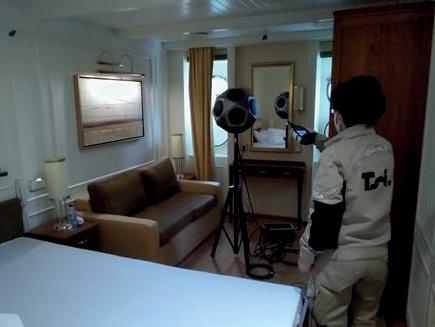
16 minute read
Silent vessels
Electric ferries contract
Two new zero emissions electric ferries will be built for the Riveer ferry service in the Netherlands. Holland Shipyards Group has signed a contract for the vessels, due to be delivered at the end of 2022.
”The fact that these ferries will soon be sailing in front of our own door makes it a great eyecatcher and a great company reference,” said Holland Shipyards director, Leendert Hoogendoorn. This November, Holland Shipyards Group will start building the emission-free ferries which have been designed by Coco Yachts, a Gorinchem-based ship designer.
BUILDING SILENT VESSELS
A Spanish engineering fi rm has acquired new technology to help shipbuilders construct ‘silent’ vessels.
Técnicas y Servicios de Ingeniería (TSI) has invested in state-of-the-art technology which enables measurement of exterior noise generated by all types of ships, including underwater radiated noise (URN) and its impact on marine life.
TSI said that with this new technology, it will be able to take a leading role in the construction of ‘silent vessels’, becoming a specialist consultant on noise and vibration for shipbuilders in Spain.
The technology from noise specialist, Hottinger Brüel & Kjær (HBK), has three HBK sound level meters (Types 2270 and 2260), an OmniPower Sound Source Type 4292, Power Amplifier Type 2734, Sound Intensity Probe Type 3599 and three Type 8104 hydrophones, to tackle the different measurements and tests that are regularly carried out in the development of new build ships.
In addition to monitoring environmental effects, the health of staff and the vessels themselves can also be affected by a loud ship. The new technology will help TSI pick up noise which is often an indicator of onboard vibration problems that can lead to equipment and system damage.
8 With the new technology, TSI said it will be able to
take a leading role in the construction of ‘silent vessels’
TSI is a Spanish enterprise established in 1983 and provides noise and vibration engineering solutions for the marine, power generation ), industry, petrochemical and defence markets.
Its portfolio of specialised services covers noise and vibration measurement and analysis, predictive maintenance or condition based maintenance, start up, breakdown consultancy, structural analysis: static and dynamic, condition monitoring systems and training.
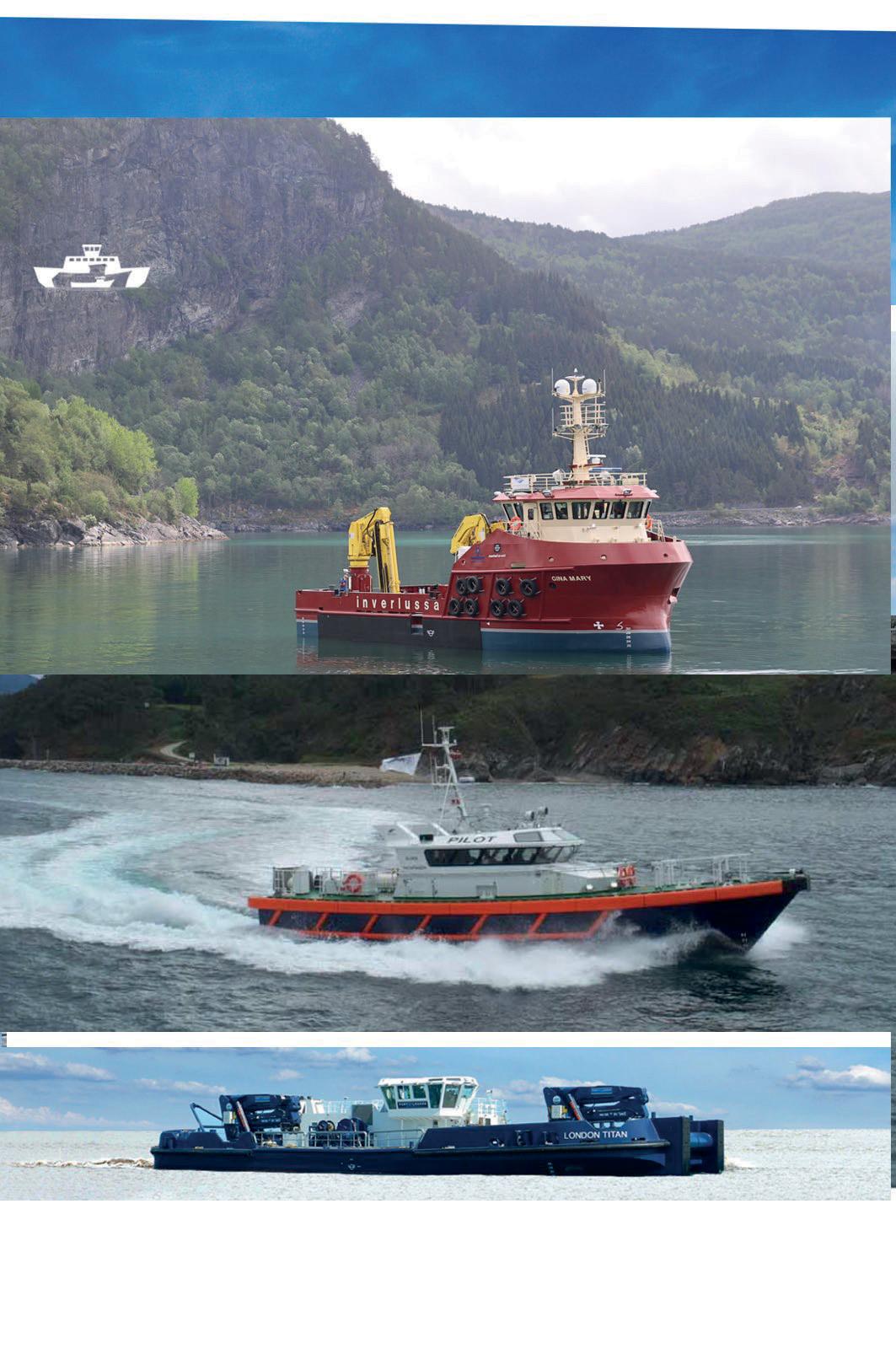













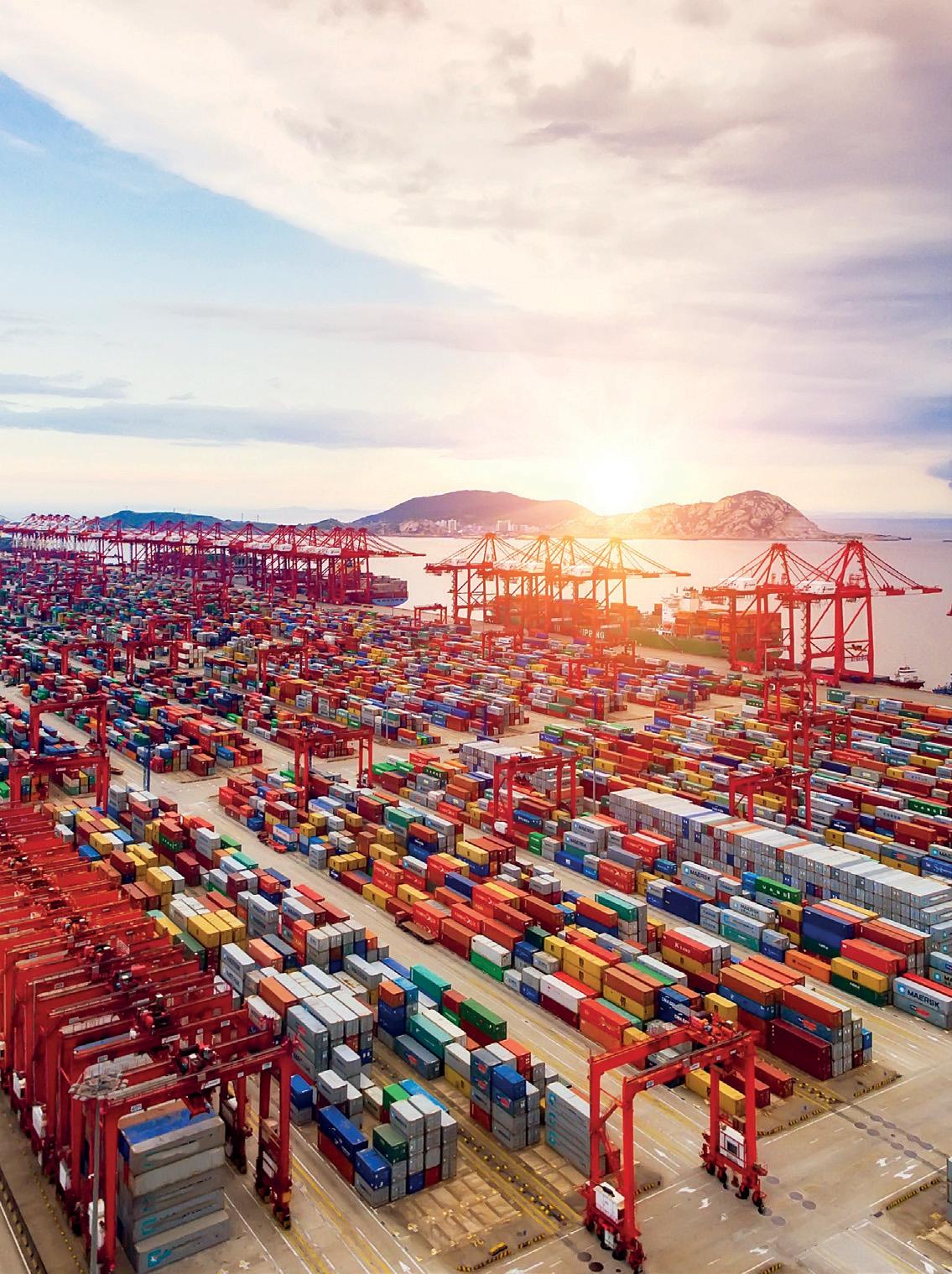


Informing over
port and terminal professionals around the world
• Instant access to industry news • Expert opinion • Monthly features • Weekly eNewsletter
visit portstrategy.com email subscriptions@portstrategy.com or call +44 1329 825 335
portstrategy.com
FOILING HYDROGEN FUEL CELL CHASE BOAT
We’re not usually in the habit here at MJ of covering yacht racing chase boats, but when it’s a ground-breaking full foiling, hydrogen powered 50kn boat, it’s a diff erent matter
Ever since the America’s Cup moved to 40kn+ foiling race boats, fi nding suitable chase boats for the teams, race judges etc. that can actually keep up, in comfort, in the often choppy conditions in which the races are held has been something of a challenge, and doing so without burning hundreds of litres of diesel per hour has been doubly so.
With that in mind, we hear with interest that Emirates Team New Zealand and Toyota’s prototype hydrogen foiling chase boat for the next chapter of the America’s Cup is in the final stages of a complex fit out prior to its launch in March.
The construction of the boat was started in August 2021 at the team’s North Shore build facility, the appendage construction (Foils, drives and rudders) is in its final stages and the Hydrogen Fuel Cell Powertrain installation is underway at the team’s base in Auckland’s Viaduct Harbour.
BOUNDARIES
The ETNZ Hydrogen project powered by Toyota has been an important one for Emirates Team New Zealand who, as Defender of the America’s Cup, have committed to driving hydrogen innovation in the marine industry through working with clean technologies.
“The Hydrogen project has been a completely new challenge across the board for Emirates Team New Zealand designers, builders and engineers,” said Head of Design Dan Bernasconi. “These types of projects are extremely beneficial to keep the guys pushing the boundaries, continually learning and approaching problems with different perspectives, which all help to keep raising the bar in our design approach to the 37th America’s Cup which is also progressing in parallel.”
The prototype foiling boat is 10 metres in length, and approximately 5200kg displacement, the cruising speed will be 30-35 knots with a top speed of around 50 knots and will carry 6 crew members with a range of between 150-180km generating approximately 440kW peak power via a 400V DC system powered by the hydrogen fuel cell.
“A project like this is not a straightforward one, and we have had to pull together a wide range of suppliers and components for this prototype boat, parts of which look like something out of Back to the Future,” explains Project Manager Geoff Senior.
“Toyota New Zealand and the Toyota Motor Corporation Japan have been a significant part of the project in supplying the 2 x 80kW pre-production Toyota Hydrogen Fuel Cells. Global Bus Ventures have supplied the Hydrogen Powertrain system design and integration and Gurit have been a valuable partner with the composite materials and engineering.”
INTEGRATED PROPULSION
The four hydrogen storage tanks onboard from Hexagon Purus will store 33kgs of hydrogen gas at 350bar while the propulsion is via a Mercury bottom end propeller which is integrated into the foils. The design of the foil wings by the Emirates Team New Zealand design team was largely based on AC75 technology and the Autopilot which will be used to control the ride height is ETNZ proprietary technology that will be implemented in the new AC40 boats in production.
Michael Rasmussen ETNZ Mechatronics Engineer said, “It is a learning curve for everyone involved, but it always is when we are driving technology into new territory. But with that comes really focused engagement from everyone involved to produce something we hope will reach the objectives we set out to achieve in driving a clean change in the global marine industry from down here in New Zealand.
It will be an exciting yet stressful time once we are ready to get it out onto the water and put it to the test, which seems to be the way with every boat Emirates Team New Zealand creates.”
The prototype boat is expected to launch early next month and will be put through a thorough sea trial to work through all the complex systems involved to get the boat up and flying.
GREEN HYDROGEN
An integral supporter to The ETNZ Hydrogen project powered by Toyota is Emirates Team New Zealand Sustainability Ambassador and former Chair of Directors, Sir Stephen Tindall, who along with helping to fund the project also believes that strategically clean hydrogen will be a very important part of New Zealand’s green sustainability in future.
“Green hydrogen comes from renewable energy like wind, solar and hydro and once the hydrogen is used in the boat, the only by-product is water.” said Tindall.
“I believe our ambitious move into hydrogen boats by Emirates Team New Zealand will set the scene for motor driven craft as we did in starting the marine foiling revolution. I am looking forward to seeing millions of hydrogen driven vehicles and boats over the next 20 years.”
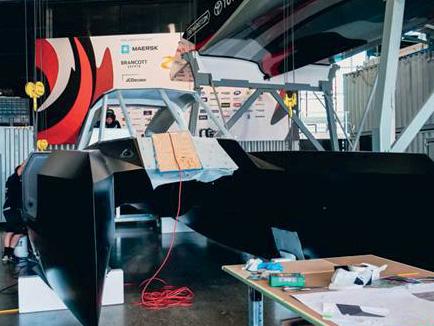
8 The chase boat
prototype is on track for March completion
SAIL CARGO SHIP WILL LAUNCH IN 2023
French shipbuilder Piriou has just signed a contract with TOWT for the design studies and the construction of an 81 metre sailing cargo ship.
After the design studies phase, the ship construction will take 18 months. This unit will be outfitted in Concarneau and the launch is planned for summer 2023. The ship is designed for 320 days at sea per year.
Navigation is principally sail-powered, but the ship also has a hybrid power mode, with one or two engines operating, at different levels of power. The ship will be designed and built with wind as the principal power source, with a sail rigging spread over two masts. In addition to its wind propulsion, it is equipped with of two turbocharged 4stroke marine diesel engines. On the bridge, there will be a single command station and its ergonomics will allow the officer of the watch to carry out all the commands and course adjustment operations, excluding manoeuvres, alone.
The ship and all its equipment will comply with the regulations on cargo vessels performing international trips and will comply with the regulations relating to cargo vessels with a gross register tonnage greater than 500UMS.
Vincent Faujour, Chairman of the Piriou group commented: “A few weeks after announcing the signing of a contract for the construction of Jean-Louis Etienne’s sailboat Septième Continent, Piriou is proving that the shipyard is at the forefront of innovation regarding the progress of sailing technologies and the decarbonization of maritime transport”.
Guillaume Le Grand, Chairman of TOWTTransport wind transport, added: “Today, TOWT is going further by ordering a ship from Piriou that will transport up to 20,000 tonnes of goods per year by sail power. The sailing cargo ship, which will be completed in 2023, will make it possible to reduce CO2 emissions by more than 90% and to economise 20 g of CO2 per tonne

8 3D image of the future TOWT sailing cargo ship
transported per kilometre. It will therefore save 3,000 tonnes of CO2 per year. In addition to the carbon savings, principally wind-powered propulsion will allow a significant reduction in the air pollution caused by the heavy fuel oil generally used by merchant ships.”
The sailing cargo ship, which will be completed in 2023, will ‘‘ make it possible to reduce CO2 emissions by more than 90% and to economise 20 g of CO2 per tonne transported per kilometre
Built by UK RIB builders Ring Powercraft the new ‘Vampire’ is a collaboration project to create a Rapid Deployment Transporter on a fully modular RIB platform.
The boat builder has teamed with top tier marine companies to deliver a high performance transport platform with the ability to meet multiple operational requirements. The open aft deck with quick release track mounting system facilitates deployment and recovery of everything from Drones to Quad Bikes.
The first variant on the water is the VT-1050, the smaller of two model sizes, boasting a twin personal watercraft system, with the larger VT-1250 having capacity for four PWCs plus crew. This blended COTS product will offer a variety of standard track mounted modules and Ring’s design team will also offer a bespoke service to facilitate specific equipment/loading requirements. A wide range of propulsion options are available with air, land or sea insertion variants.
Ring has worked wit the following partners to deliver this capable product: 5 Alamarin: Water Jet and Sigma control system 5 EP Barrus: Yanmar inboard engines 5 Golden Arrow Marine: Tactical Water Craft 5 Henshaw Inflatables (Wing Group): Hypalon
Tubes 5 Seadek: HD shock mitigating flooring 5 Simrad: Tech Equipment 5 Ullman: Suspension seating and Steering
Bar System 5 Vanclaes: Jet Ski Loader track module
Ring’s CEO David Jackson said: “Vampire is a ground breaking project in pursuing our vision for modular boating across our ranges. Applications for commercial and tactical functions were a key driver, however, the multi-functional aspect also appeals to the leisure and Superyacht sectors and you will see this theme continue in our future product launches including the Arksen 45. The ability to easily transform the boat’s function in a matter of minutes has cost and operational benefits for all types of professional users, individuals and families who want the freedom to be able to enjoy a wide range of activities.
We chose a collaborative approach to optimise design by working with top industry experts in their various fields relating to the craft and its operation. I would like to thank all of our partners who have shown outstanding support from supply, technical and resource perspectives. Our thanks also go to the many end users who have kindly assisted with their invaluable feedback. Our ambition to be the partner of choice for innovative marine projects remains core to our strategy.”
NEW TACTICAL RIB IS A WHO’S WHO OF CUTTING EDGE EUROPEAN COMMERCIAL MARINE PLAYERS
8 Ring Vampire is starting its journey as a
commercial and tactical platform
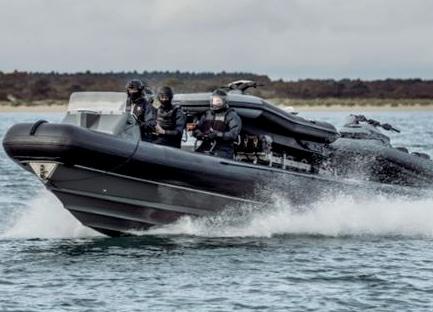
WHEN INTELLIGENT ERGONOMICS MEET RESPONSIBLE RESINS
A Scottish independent workboat operator has recently taken delivery of an 11m RIB that breaks new ground in its design and materials
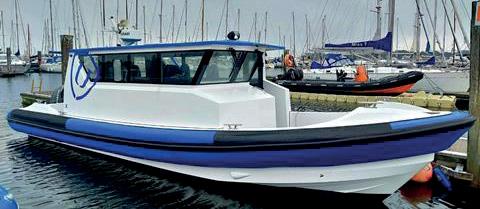
McLachlan Marine, one of the largest independent workboat operators in the North East of Scotland has taken delivery of the new O-CLASS, which was built by Glasgowbased The Ultimate Boat Company.
The O-CLASS is a high-performance offshore craft that has been specifically designed and engineered as a ‘heavy-lift’ commercial vessel. Its intelligent ergonomics and superior shock mitigation technology provides a safer working environment for professional crew at sea for extended periods.
Extra-wide gunwales, incorporating a durable anti-slip coating, make stepping up to a ladder or dockside easier and safer. The spacious ‘best in class’ deck areas are enclosed by high vertical sides which provide enhanced security and confidence for the crew when operating in big seas.
REVOLUTIONARY HULL
All UBC powerboats benefit from a revolutionary and patented hull technology that introduces compression or hydraulic lift resulting in vastly superior load carrying, manoeuvrability, performance, and stability – all of which are essential for serious offshore craft such as these.
The hull has been designed by internationally renowned naval architect, John Moxham, who has had an illustrious career in the marine industry, from designing military highspeed craft through to creating the UK’s fastest RNLI lifeboat (E-Class Mark I). He was also at the forefront of using GRP for boats, designing the first mass-produced outboardpowered cabin cruiser, the ‘Microplus’ and is wellknown for his work on high-performance designs for brands such as Avon, Ribeye, Scorpion, and now The Ultimate Boat Company. This latest venture is, he says, “the pinnacle of my career”.
For UBC’s pioneering portfolio of powerboats, John has completely redesigned the hull to fundamentally redefine the way a planing hull interacts with the water, positioning the company at the forefront of hull design and powerboat building.
Hydraulic lift is generated by the ‘Moxham Retaining Rails’ that modify and then manipulate waterflow beneath the craft. The hull improves waterflow across the propellers, increasing grip to achieve superior manoeuvrability and tighter turning with little loss of speed.
It also introduces a major practical advantage by enabling the helm to easily maintain a constant visual on the horizon through its linear transition onto the plane, derived by mitigating stern squat and associated bow lift.
McLachlan Marine’s new boat, which is to be based on the West Coast of Scotland, will be used for safety boat duties, dive support and fast response operations.
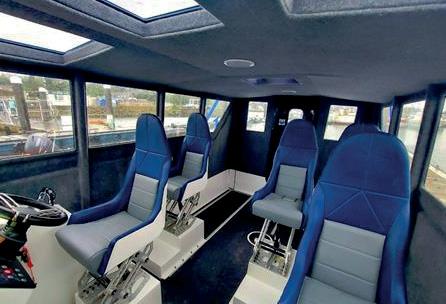
SUSTAINABLE COMPOSITE
The Ultimate Boat Company gave the O-CLASS its official world launch at the recent Southampton Boat Show, which generated a high level of media and industry interest in the boat, the high-performance hull design, and the new fully recyclable and sustainable composite material that UBC is pioneering as an option for its high-performance boat hulls in conjunction with its parent company, ExoTechnologies.
The material, named ExoMarineTM, the marine variant of DANUTM, has been created as an alternative to glass reinforced plastic (GRP), to combat the growing problem of end-oflife GRP hulls going to landfill. This natural core material comprises a combination of styrene-free resin and sustainable fibres, is stronger and lighter than fibreglass and less brittle than carbon fibre. Crucially, its cost is comparable with traditional materials, and no additional manufacturing or labour costs are required.
8 Hydraulic lift
is generated by the ‘Moxham Retaining Rails’ that modify and then manipulate waterfl ow beneath the craft
8 The O-CLASS is a
high-performance off shore craft
8 Underwater radiated noise is
becoming more of a concern
UNDERWATER RADIATED NOISE IS POLLUTION TOO
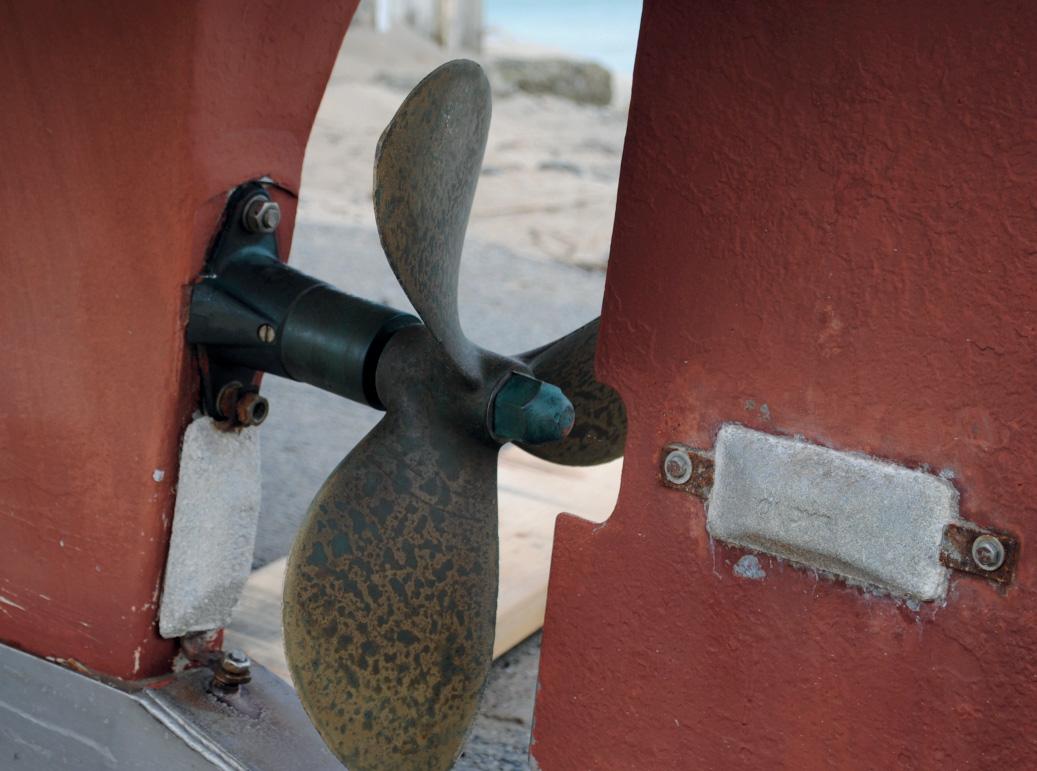
Classifi cation society The Korean Register (KR) has developed new ‘Guidance for Underwater Radiated Noise’ which will help protect marine ecosystems by reducing noise from ships.
As ships’ size and speed increases to handle high volumes of seaborne trade so underwater radiated noise is becoming a more serious issue, causing increasing disruption to the marine ecosystem. The IMO’s Marine Environment Protection Committee (MEPC) is discussing measures to mitigate this growing challenge. As a result, new regulations are expected shortly, which will determine sensitive areas to noise, where ships calling in that area will be required to meet appropriate standards for underwater radiated noise.
The maritime industry is also focused on developing core technologies to address the issue as environmental regulations are
tightened, as part of the overall paradigm shift to more eco-friendly ships. In support of this industry move, KR has developed a class notation for underwater radiated noise and Guidance which is based on ISO 17208 (International standard of quantities and procedures for description and measurement of underwater sound from ships). The Guidance covers the noise standard for two operating conditions: normal operation (transit) and quiet operation (quiet).
The class notation is given in the form of ‘URN-T(20)’, which indicates that when a ship operates at a speed equivalent to 20 knots in still water, it meets the transit criteria for underwater radiated noise. URN is an abbreviation for underwater radiated noise.
A KR official said: “Several countries and ports have already introduced regulations relating to underwater radiated noise, and some ports, such as the Port of Vancouver, are offering discounts on port user fees for vessels that meet the standards. If our customers’ vessels have obtained KR’s class notation for underwater radiated noise, they will also be able to benefit from these advantages while reducing their impact on the maritime environment.”







